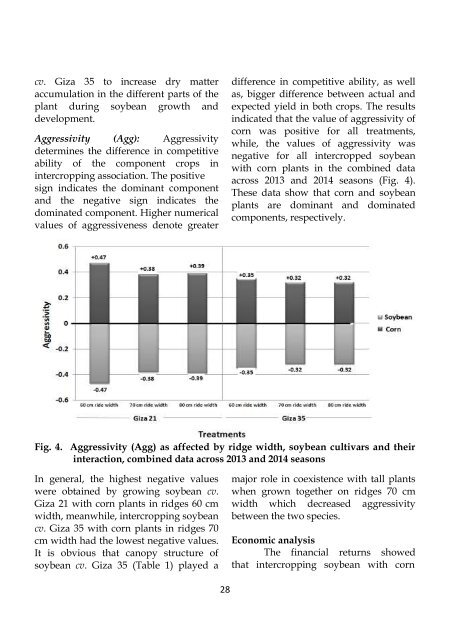SOYBEAN RESEARCH
Soybean-Research-14(2)-2016
Soybean-Research-14(2)-2016
Create successful ePaper yourself
Turn your PDF publications into a flip-book with our unique Google optimized e-Paper software.
cv. Giza 35 to increase dry matter<br />
accumulation in the different parts of the<br />
plant during soybean growth and<br />
development.<br />
Aggressivity (Agg): Aggressivity<br />
determines the difference in competitive<br />
ability of the component crops in<br />
intercropping association. The positive<br />
sign indicates the dominant component<br />
and the negative sign indicates the<br />
dominated component. Higher numerical<br />
values of aggressiveness denote greater<br />
difference in competitive ability, as well<br />
as, bigger difference between actual and<br />
expected yield in both crops. The results<br />
indicated that the value of aggressivity of<br />
corn was positive for all treatments,<br />
while, the values of aggressivity was<br />
negative for all intercropped soybean<br />
with corn plants in the combined data<br />
across 2013 and 2014 seasons (Fig. 4).<br />
These data show that corn and soybean<br />
plants are dominant and dominated<br />
components, respectively.<br />
Fig. 4. Aggressivity (Agg) as affected by ridge width, soybean cultivars and their<br />
interaction, combined data across 2013 and 2014 seasons<br />
In general, the highest negative values<br />
were obtained by growing soybean cv.<br />
Giza 21 with corn plants in ridges 60 cm<br />
width, meanwhile, intercropping soybean<br />
cv. Giza 35 with corn plants in ridges 70<br />
cm width had the lowest negative values.<br />
It is obvious that canopy structure of<br />
soybean cv. Giza 35 (Table 1) played a<br />
major role in coexistence with tall plants<br />
when grown together on ridges 70 cm<br />
width which decreased aggressivity<br />
between the two species.<br />
Economic analysis<br />
The financial returns showed<br />
that intercropping soybean with corn<br />
28


